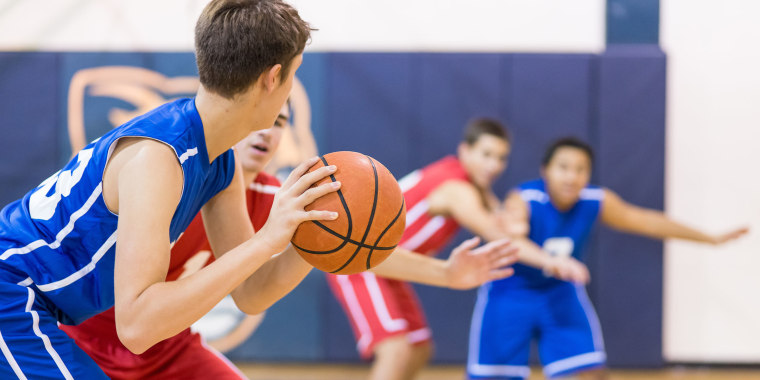During 10th grade, children are nearing the end of puberty and the rapid and profound changes that are taking place as they mature into adults. Although they will continue to grow and mature for a couple more years, they are now young adults. Tenth-graders are usually 15 or 16 years old, and the physical health guide below covers adolescents in the typical age group. However, keep in mind that the information here is intended only as a general guide. If you are concerned about your teenager’s physical development, you should consult your pediatrician or family physician.
Physical activity
Overview
Engaging in regular physical activity and exercise is essential for adolescents. It promotes growth, helps build strength and develop healthy bodies, and can even enhance academic performance. Regular physical activity also reduces the risk of obesity and chronic diseases, such as diabetes, cardiovascular disease, and certain cancers. Many children become less physically active with the onset of puberty, increasing their risk of developing conditions such as diabetes and obesity. Regular physical activity and exercise can help adolescents feel in control of their bodies and can also be a helpful way of dealing with the stress and emotional changes that occur during puberty.
Benefits
The benefits to your child of physical activity can include:
- Increased self-sufficiency and confidence
- Improvements in learning
- Better sleep
- Weight management
- Stress management
- Improved social skills
- Decreased time spent watching TV or playing with computers
- Decreased risk for chronic diseases later in life
Recommendations
The U.S. Department of Health and Human Services recommends that children and adolescents participate in at least 60 minutes of vigorous or moderate-intensity physical activity each day. This does not need to be 60 minutes of sustained activity at a time, but can include different episodes of activity that, together, total 60 minutes or more. Adolescents should take part in a variety of activities that require different degrees of exertion. These should include vigorous activities, such as running, and more moderate activities, such as brisk walking.
Maintaining healthy habits
The proportion of young people who meet the recommended guidelines for physical activity declines as children age, and adolescents are often likely to become less active as they get older. This decline comes just as maintaining a healthy level of physical activity becomes more important than ever, as children mature into their adult bodies. Research has found that the number of fat cells in our bodies is set during adolescence, and although these cells can shrink or expand later in life, they cannot be eliminated. Establishing and maintaining healthy physical activity habits at this age will help set adolescent bodies on a path to lifelong fitness and well-being.
Vigorous physical activity
The guidelines recommend that children and adolescents engage in vigorous physical activity at least three times a week. This can include playing soccer, doing martial arts, or riding a bike.
Building muscle
Building muscle strength is especially important for children and adolescents, and exercise is key to achieving this goal. Muscle-strengthening activities are those that force the muscles to do more than the normal workload and should include all the major muscle groups of the body. Examples of muscle-strengthening activities include climbing, sit-ups, and resistance exercises. The guidelines recommend that children and adolescents engage in muscle-strengthening activities at least three times a week.
Bone mass
Adolescence is a crucial time for building bone mass, up to a quarter of which is formed during the adolescent growth spurt, from around the age of 9 until the end of puberty. Bone-strengthening exercises build strength through the force that is exerted on the bones. Activities that achieve this important goal include jumping, running, skipping rope, and playing tennis or volleyball. The guidelines recommend that adolescents engage in bone-strengthening activities at least three times a week.
Sleep
Sleep overview
Despite the added demands and pressures of high school, it is important for your child to continue to prioritize sleep. Experts stress that adequate sleep is as important to a healthy lifestyle as a balanced diet and physical activity. Due to the biological changes that occur during puberty, a teenager's natural sleeping pattern typically shifts backwards, causing them to not feel tired until later in the evening. For some adolescents, it is natural to not be able to fall asleep before 11 p.m. With school starting earlier and bedtimes getting later, the vast majority of teenagers are not getting the recommended amount of sleep each evening. This lack of sleep can negatively affect both a student’s academic and sports performance, by limiting their ability to concentrate and increasing their likelihood of sustaining an injury. If you notice significant changes in your child’s sleeping habits, it may be a sign that other health-related issues are a factor. Consult with your child’s health care provider about steps you can take to ensure your child gets a more restful night of sleep.
Nightly sleep needs
Sleep needs do not drop significantly as your child matures into adolescence even though their schedule may become tighter. Experts recommend that high school students sleep for about 9 hours and 15 minutes each evening so that they are able to function at their best. To achieve this goal, a student who needs to be up by 6:15 a.m. to get ready for school should be in bed no later than 9 p.m. Though a 9 p.m. bedtime may seem unattainable to some, experts recommend making sleep a priority by encouraging your child to get as much sleep as possible. The closer they are to getting the recommended amount of sleep, the better.
Learn more about supporting your child with our 10th grade physical health tips page.
Parent Toolkit resources were developed by NBC News Learn with the help of subject-matter experts, including Dr. Natasha Burgert, Pediatrician, Pediatric Associates and Dr. Jayne Greenberg, District Director, Miami-Dade County Public Schools.
